How are crater-like scars formed?
| It is believed that sharks Isistiu brajiliensis (Quoy & Gaimard, 1824) are probably the culprits that cause crater-like
wounds on fishes and cetaceans. The author (Ref.1.) deduced that these
sharks bite their prey and close their lips together at the same time,
then rotate their bodies to cut a piece of meat from the prey. That is
why Isistiu brajiliensis is named the Cookiecutter shark. However, some parts of the author's description are not specific as to how the pieces of meat are cut from the prey. Therefore, we carried out simple experiments using the isolated jaws of sharks to see how sharks can actually create crater-like wounds on fish. First, we attempted an experiment using an isolated jaw of Isistiu brasiliensis, but found that the upper jaw of this shark is extreamly fragile to be used in the planned experiment. Therefore, we used an isolated jaw of Dalatias licha instead. The dental morphology of these two shark species belongs to a cluthcing-cutting subtype .Experimental results strongly suggest that I. brasiliensis, like many sharks with clutching-cutting type teeth, also cuts pieces of meat from its prey by scooping up and rocking its entire body. The under heads and jaws of these two species and Squalus mitsukurii, for comparison, are shown in Figure 1a and 1b. |
| Fig. 1a. |

| Fig. 1b. |

| Experiment 1: An isolated jaw of Dalatias licha was held in a hand, pressed against the body of a parrot fish, and rotated or moved right and left to observe how the wound was formed. The jaw used was isolated from a female of Dalatias licha of 63 cm T.L.. Scales and dangerous spines of the dorsal fin of the parrot fish were removed beforehand. |
| The result. is shown in Figure 2. The shark's jaw was able to form a crescent-shaped wound on the parrot fish with relative ease, but was completely unable to excize a piece of flesh and leave a crater-shaped wound behind. |
| Fig. 2. |
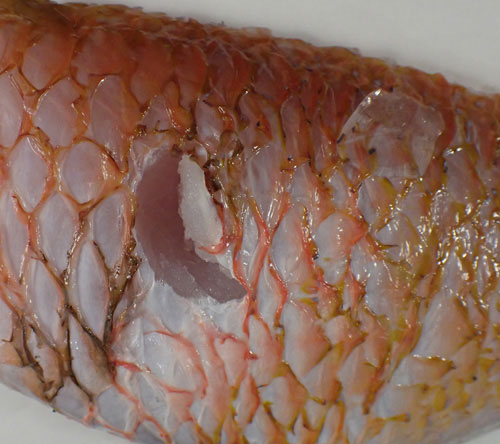
| Experiment 2: As mentioned above, the isolated jaw with clutching-cutting type tooth morphology of Dalatias licha failed to form a crater-like scar. Next, another experiment was carried out on a dogfish shark with cutting type dental morphology as a shark with the potential to form such wounds. The jaw used was isolated from a female Squalus mitsukurii of 80 cm T.L.. The result is shown in Figure 3. As a result, by rotating the shark's jaw with a hand, I managed to cut a piece of flesh from the fish, leaving a crater-shaped wound. |
| Fig. 3. |
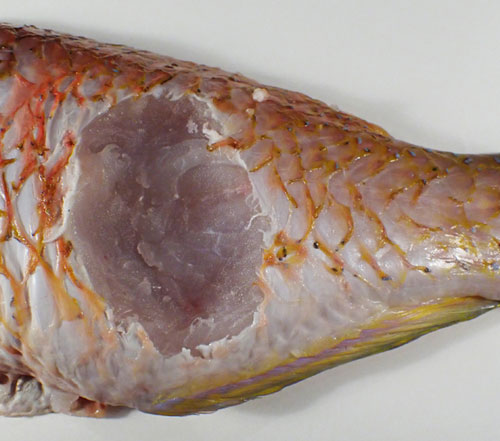
| Experiment 3: In the experiment 1 using the jaw of Dalatias licha, we were able to create crescent-shaped scratches on the fish by vibrating the lower teeth using the upper teeth as anchors. However, we were unable to rotate the jaws to create a crater-like wound, and we speculated that the upper teeth would be easily destroyed if we performed the same experiment on the jaw of Isistius brasiliensis. |
| Some time after the experiment was conducted, one of my colleagues suggested
that the shark was scooping up pieces of meat from its prey rather than
spinning it. Therefore, a similar experiment was carried out using the
scooping method instead of rotation. As before, the jaw of Dalatias licha was used and mackerel was used as the prey fish. |
| Fig. 4 shows the crescent-shaped wound caused by the rotation attempt. Fig. 5 shows crater-like scars created by the scooping method, and Fig. 6. is a magnified view of the crater-like scar formed by the scooping method.. |
| Fig. 4. Crescent-shaped wound caused by the rotation attemp |
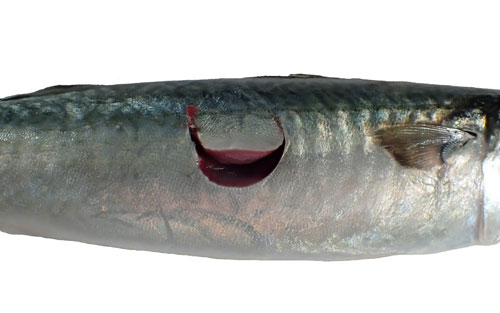
| Fig. 5. Crater-like scars created by the scooping method |

| Fig. 6. Magnified view of the crater-like scar. |
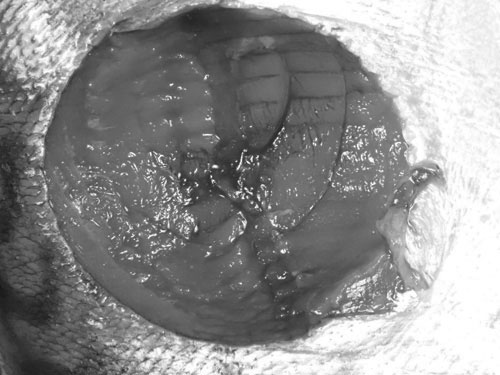
| Experiment 4: Experiment 3 was not successful in creating crater-like wound by rotation. This was due to the upper teeth interfering with the rotation. Therefore, the next experiment was conducted without using the upper teeth. As a result, crater-like wound was easily created by rotating the jaw of D. licha (Fig. 7, Fig. 8). |
| Fig. 7. Crater-like scars created by the rotating method |
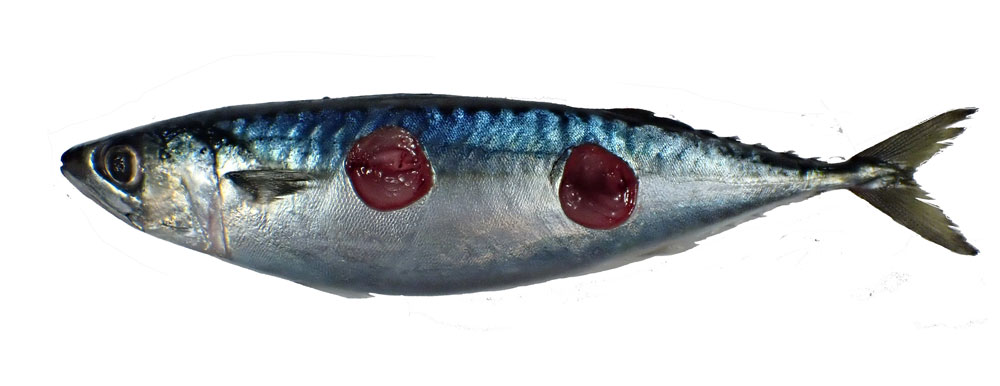
| Fig. 8. Magnified view of the crater-like scar. |
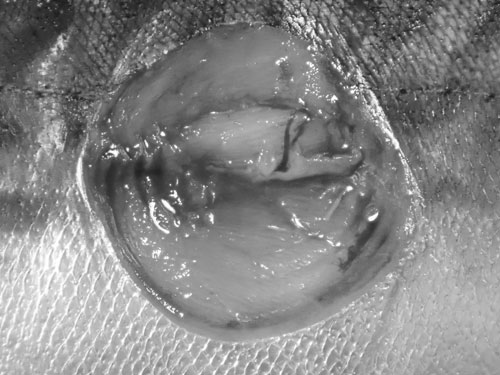
| These results indicate two possible behaviors by which I. brasiliensis leaves crater-like scars on its prey: one is by scooping, and the other is by rotating without using its upper teeth. In the latter method with rotation, the first step is scoop-up by the lower teeth, and the next step is rotation. In other words, this is the scoop-up and rotate method. A close examination of the scars reveal which method the shark uses. However, it must be fresh scars. Comparing both methods, the former method is easier and more reasonable. The latter method of first scooping up and then rotating is probably used only in very special cases. Like many sharks with clutching-cutting type teeth, I. brasiliensis can be assumed to cut a piece of meat from its prey by scooping it up and rocking its entire body. |
| Additional Experiment 5: Underwater, a certain fish makes a water sucking motion, forming negative pressure in its mouth and adsorbing on its prey. How is it possible for that fish to rotate while maintaining that state? The experimentt was performed very simply using a plastic dropper. I put the dropper under negative pressure in the water. I then press it against my palm and let it suck on it. Then I rotate the dropper. To my surprise, the dropper stuck firmly to my palm and I could easily rotate it many times |
| Ref. 1. Isistius brasiliensis, A SQUALOID SHARK,, THE PROBABLE CAUSE OF CRATER WOUNDS ON FISHES AND CETACEANS, EVERET C. JONES FISIIERY BULLETIN: VOL. 69, NO. 4. 1971 |
| Ref. 2. Dental morphology |
| Clutching-cutting subtype dental morphology 1: Isistius brasiliensis female, 31 cm T.L |
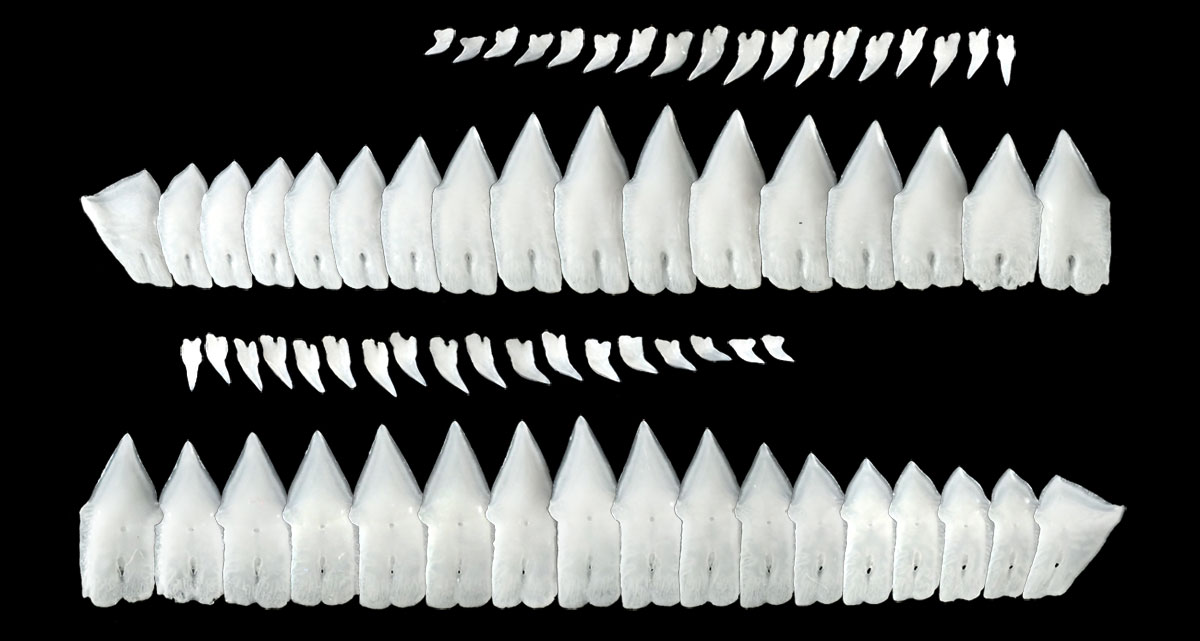
| Clucthing-cutting subtype dental morphology 2: Dalatias licha male, 37 cm T.L. |

| Clucthing-cutting subtype dental morphology 3: Etomopterus pusillus male, 21.8 cm T.L. |

|
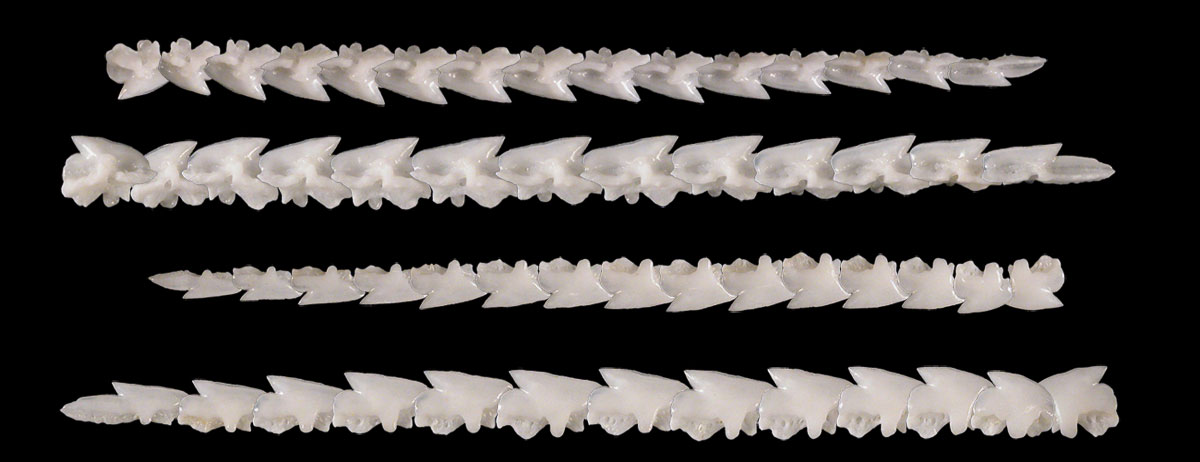
ver. 3: Mar. 16, 2023, ver. 1: Dec. 23, 2022